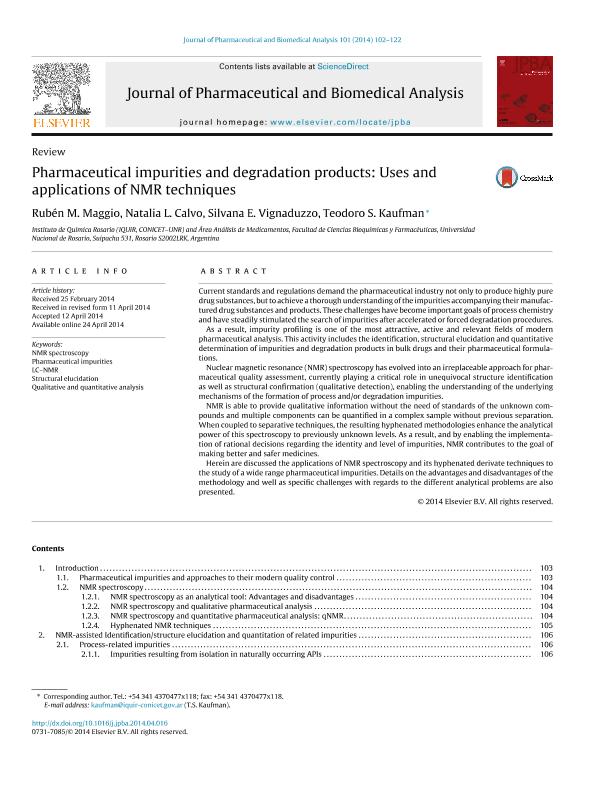Artículo
Pharmaceutical impurities and degradation products: Uses and applications of NMR techniques
Fecha de publicación:
04/2014
Editorial:
Elsevier
Revista:
Journal of Pharmaceutical and Biomedical Analysis
ISSN:
1873-264X
e-ISSN:
0731-7085
Idioma:
Inglés
Tipo de recurso:
Artículo publicado
Clasificación temática:
Resumen
Current standards and regulations demand the pharmaceutical industry not only to produce highly pure drug substances, but to achieve a thorough understanding of the impurities accompanying their manufactured drug substances and products. These challenges have become important goals of process chemistry and have steadily stimulated the search of impurities after accelerated or forced degradation procedures. As a result, impurity profiling is one of the most attractive, active and relevant fields of modern pharmaceutical analysis. This activity includes the identification, structural elucidation and quantitative determination of impurities and degradation products in bulk drugs and their pharmaceutical formulations. Nuclear magnetic resonance (NMR) spectroscopy has evolved into an irreplaceable approach for pharmaceutical quality assessment, currently playing a critical role in unequivocal structure identification as well as structural confirmation (qualitative detection), enabling the understanding of the underlying mechanisms of the formation of process and/or degradation impurities. NMR is able to provide qualitative information without the need of standards of the unknown compounds and multiple components can be quantified in a complex sample without previous separation. When coupled to separative techniques, the resulting hyphenated methodologies enhance the analytical power of this spectroscopy to previously unknown levels. As a result, and by enabling the implementation of rational decisions regarding the identity and level of impurities, NMR contributes to the goal of making better and safer medicines. Herein are discussed the applications of NMR spectroscopy and its hyphenated derivate techniques to the study of a wide range pharmaceutical impurities. Details on the advantages and disadvantages of the methodology and well as specific challenges with regards to the different analytical problems are also presented.
Archivos asociados
Licencia
Identificadores
Colecciones
Articulos(IQUIR)
Articulos de INST.DE QUIMICA ROSARIO
Articulos de INST.DE QUIMICA ROSARIO
Citación
Maggio, Ruben Mariano; Calvo, Natalia Lorena; Vignaduzzo, Silvana Edit; Kaufman, Teodoro Saul; Pharmaceutical impurities and degradation products: Uses and applications of NMR techniques; Elsevier; Journal of Pharmaceutical and Biomedical Analysis; 101; 4-2014; 102-122
Compartir
Altmétricas




